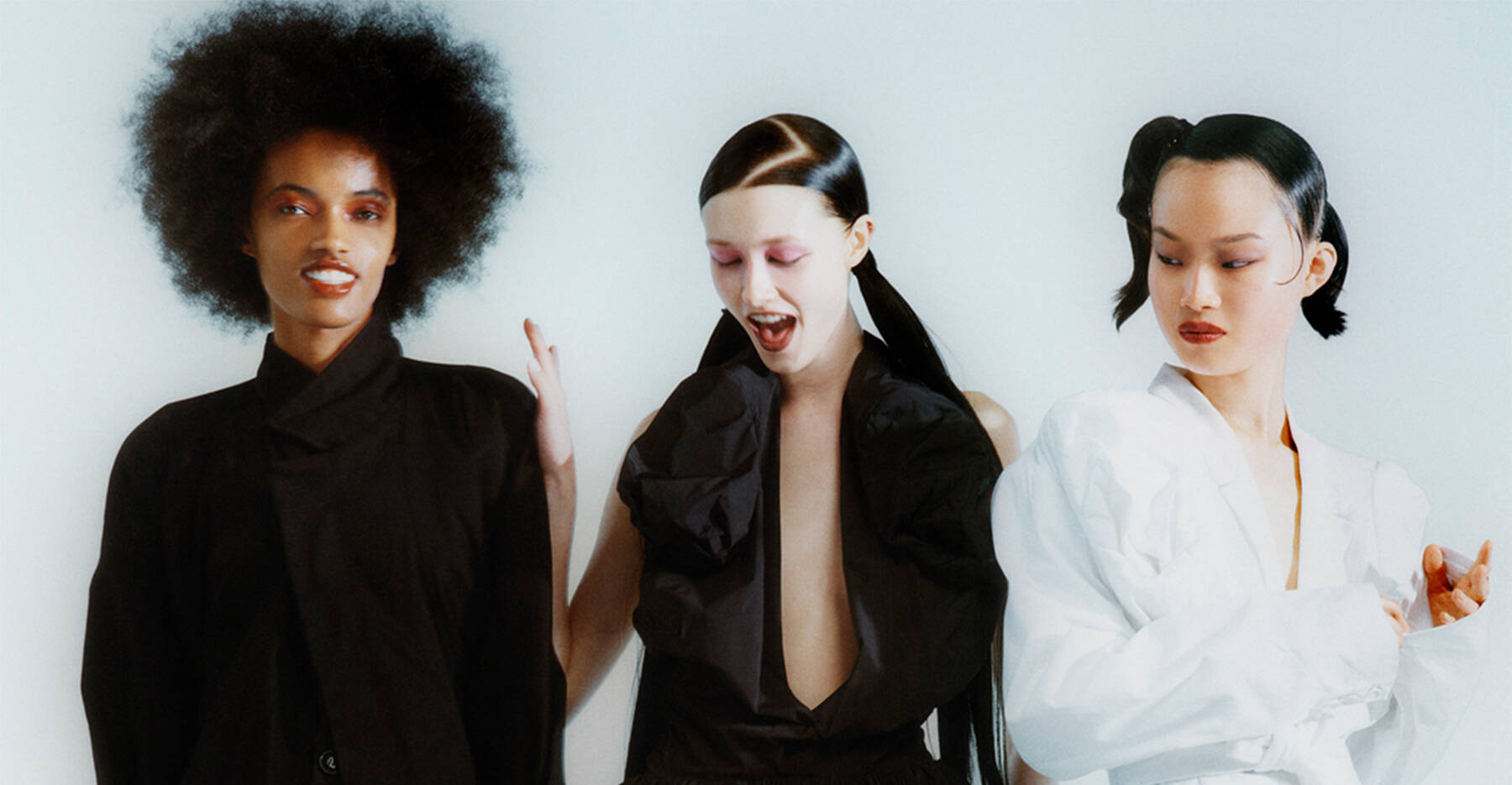
Rewrite
Life never sits idle on East London’s Ridley Road. Exit Dalston Kingsland Overground station and you’re greeted with the road’s eponymous market, its perimeter lined with stalls set up under multicoloured umbrellas and a soundtrack of chatter, music and flapping pigeons that come far too close to your face.
It’s here that you’ll find the studio of British designer Torishéju Dumi, 31. In her newly acquired space, I see designs from her debut collection Fire on the Mountain – which have been worn by Zendaya and Naomi Campbell (who opened her first show in Paris) – sitting neatly on rails. Despite this being her first full collection, Dumi has already been on the cover of British Vogue, appearing alongside fellow sustainability advocates Priya Ahluwalia and Tolu Coker earlier this year. And she’s exclusively stocked in Dover Street Market’s global catalogue (CEO Adrian Joffe is now a friend; she’s yet to meet Rei) and has pieces displayed at The Metropolitan Museum of Art. “Peppermint tea?” she asks, before lighting a slim cigarette that is relit regularly as she launches into the story of her career so far with equal parts speed and detail.
from left: Havana wears jacket, skirt and trousers by TORISHEJU, shoes by MANOLO BLAHNIK; Leonie and Wenli wear TORISHEJU, shoes by CHRISTIAN LOUBOUTIN
Dumi’s exposure to fashion started young. Part Nigerian and part Brazilian, she was born in Harlesden, North London, and grew up in Milton Keynes and Hertfordshire with her mum, brother and sister. Her dad (who died when she was 14) and grandfather often wore traditional attire, prompting an awareness of silhouettes unencumbered by Western constraints on gender and dress. “Seeing my grandfather and dad wear long kaftan dresses with a pair of trousers – I loved that. [It made me think], gosh, I want to be a man so I can wear that.”
This endearing all-or-nothing attitude seems to be a constant for Dumi, whose enthusiasm for her craft has driven her to seek out and absorb every morsel of knowledge she can. With a BA in menswear from London College of Fashion and an MA from Central Saint Martins, she used her student years to work in New York for Phillip Lim, at Phoebe Philo’s Celine in Paris and then in Antwerp for Ann Demeulemeester (a move she thought was “chic and bohemian” – it was). There she learned the value of archiving and manifested one of her core design tenets. “A T-shirt’s a T-shirt,” she says. “At the end of the day, everything’s been done before. It’s how much can you make it yours?” That’s where the beauty of Dumi’s designs lies. Each piece feels both closely personal and distinctly otherworldly. “You have to build,” she says. “World-building with fashion is why I chose it. You’re able to show people a dream and I love it.”
Valuing the past does pop up for Dumi in a physical manner, with deadstock and vintage fabrics becoming bases for her garments. “I’ve always been sustainable,” she says, “[but] I didn’t call it sustainability. It was just making do with what you have. I like finding ways to make things have a longer lifespan. That’s in the ethos of the brand, it’s about having longevity.”
Looking at her career to date, it doesn’t feel like longevity is something to worry about. Her first capsule collection, Mami Wata, released across seasons in February 2023 and inspired by a mythological water spirit from African folklore, caught the eye of Andrew Bolton, the English head curator at the Met’s Costume Institute, which acquired some pieces for its Sleeping Beauties: Reawakening Fashion exhibition. Fire on the Mountain, shown in Paris for the SS24 season, was styled by fashion editor Gabriella Karefa-Johnson, a longstanding supporter who brought Naomi on board. Paloma Elsesser walked, Edward Enninful attended and Lucien Pagès did the publicity for free. That’s a heck of a lot of heavyweights to have behind you after just one collection. Recounting this swell of support, Dumi comments, “they bet on a horse and, thankfully, this horse ran”.
The collection was a knockout, with Dumi drawing on her heritage by nodding to dress codes established when Nigeria was colonised. The offering played with dimensions and shape, coiling, wrapping and manipulating fabrics to create pieces that were surreal yet chic and impeccably made. It was a defiant debut. “I was always the only Black girl in my class,” she says, “but that doesn’t faze me because I’m going to create whatever the fuck I want to. It [all relates to] how I feel and everybody’s different, just like the Vogue cover with Priya and Tolu. It was interesting because, [even though we’re] all Black, Nigerian females, we create completely different things… I just want to create. If I didn’t have this outlet, I would go mad. There’s so much in my head that needs to get out.”
Her plans for the future are equally abundant as her overflowing ideas. “I want to develop in the world-building I do. I hope [the brand] expands [into] different dimensions and surpasses clothing stores, but in a sustainable way. And I hope that I can build a bridge that [closes] the gaps between fantasy and reality and make what’s in my head real.”
Talking to Dumi can’t help but leave you feeling like you’re watching a star that’s burning brighter every day. The way she talks about her work is wildly passionate and expansive, like she’s trying to communicate the infinite galaxy that’s inside her head. Bursting with a zeal for life, people and experiences, she is set to be a fashion supernova.
Wenli wears jacket, skirt and shorts by TORISHEJU, shoes by CHRISTIAN LOUBOUTIN
Taken from Issue 73 of 10 Magazine – RISING, RENEW, RENAISSANCE – out NOW. Order your copy here.
Photographer CLARK FRANKLYN
Fashion Editor GARTH ALLDAY SPENCER
Models WENLI ZHAO at Next Models, HAVANA OLIVER-MIGHTEN at Established Models, BELLE VANDERKLEY at Premier Models and LEONIE STEFFEN at Present Models
Hair TOMI ROPPONGI at Julian Watson Agency using Bed Head by TIGI
Make-up SUNAO TAKAHASHI at Saint Luke using DIOR Foundation and Capture Totale Le Sérum
Manicurist SASHA GODDARD at Saint Luke Artists using CHANEL Le Vernis in Ballerina and Incendiaire and CHANEL La Crème Main
Photographer’s assistants STEFAN EBELEWICZ and MARIJA VAINILAVICIUTE
Fashion assistants GEORGIA EDWARDS, SONYA MAZURYK, DONNA CHOI and HAMZA KHAN
Hair assistant ERIKA KIMURA
Make-up assistant FRANCESCA LEACH
Casting ISA ROSE CONROY
Production ZAC APOSTOLOU
in HTML format, including tags, to make it appealing and easy to read for Japanese-speaking readers aged 20 to 40 interested in fashion. Organize the content with appropriate headings and subheadings (h1, h2, h3, h4, h5, h6), translating all text, including headings, into Japanese. Retain any existing
tags from
Life never sits idle on East London’s Ridley Road. Exit Dalston Kingsland Overground station and you’re greeted with the road’s eponymous market, its perimeter lined with stalls set up under multicoloured umbrellas and a soundtrack of chatter, music and flapping pigeons that come far too close to your face.
It’s here that you’ll find the studio of British designer Torishéju Dumi, 31. In her newly acquired space, I see designs from her debut collection Fire on the Mountain – which have been worn by Zendaya and Naomi Campbell (who opened her first show in Paris) – sitting neatly on rails. Despite this being her first full collection, Dumi has already been on the cover of British Vogue, appearing alongside fellow sustainability advocates Priya Ahluwalia and Tolu Coker earlier this year. And she’s exclusively stocked in Dover Street Market’s global catalogue (CEO Adrian Joffe is now a friend; she’s yet to meet Rei) and has pieces displayed at The Metropolitan Museum of Art. “Peppermint tea?” she asks, before lighting a slim cigarette that is relit regularly as she launches into the story of her career so far with equal parts speed and detail.
from left: Havana wears jacket, skirt and trousers by TORISHEJU, shoes by MANOLO BLAHNIK; Leonie and Wenli wear TORISHEJU, shoes by CHRISTIAN LOUBOUTIN
Dumi’s exposure to fashion started young. Part Nigerian and part Brazilian, she was born in Harlesden, North London, and grew up in Milton Keynes and Hertfordshire with her mum, brother and sister. Her dad (who died when she was 14) and grandfather often wore traditional attire, prompting an awareness of silhouettes unencumbered by Western constraints on gender and dress. “Seeing my grandfather and dad wear long kaftan dresses with a pair of trousers – I loved that. [It made me think], gosh, I want to be a man so I can wear that.”
This endearing all-or-nothing attitude seems to be a constant for Dumi, whose enthusiasm for her craft has driven her to seek out and absorb every morsel of knowledge she can. With a BA in menswear from London College of Fashion and an MA from Central Saint Martins, she used her student years to work in New York for Phillip Lim, at Phoebe Philo’s Celine in Paris and then in Antwerp for Ann Demeulemeester (a move she thought was “chic and bohemian” – it was). There she learned the value of archiving and manifested one of her core design tenets. “A T-shirt’s a T-shirt,” she says. “At the end of the day, everything’s been done before. It’s how much can you make it yours?” That’s where the beauty of Dumi’s designs lies. Each piece feels both closely personal and distinctly otherworldly. “You have to build,” she says. “World-building with fashion is why I chose it. You’re able to show people a dream and I love it.”
Valuing the past does pop up for Dumi in a physical manner, with deadstock and vintage fabrics becoming bases for her garments. “I’ve always been sustainable,” she says, “[but] I didn’t call it sustainability. It was just making do with what you have. I like finding ways to make things have a longer lifespan. That’s in the ethos of the brand, it’s about having longevity.”
Looking at her career to date, it doesn’t feel like longevity is something to worry about. Her first capsule collection, Mami Wata, released across seasons in February 2023 and inspired by a mythological water spirit from African folklore, caught the eye of Andrew Bolton, the English head curator at the Met’s Costume Institute, which acquired some pieces for its Sleeping Beauties: Reawakening Fashion exhibition. Fire on the Mountain, shown in Paris for the SS24 season, was styled by fashion editor Gabriella Karefa-Johnson, a longstanding supporter who brought Naomi on board. Paloma Elsesser walked, Edward Enninful attended and Lucien Pagès did the publicity for free. That’s a heck of a lot of heavyweights to have behind you after just one collection. Recounting this swell of support, Dumi comments, “they bet on a horse and, thankfully, this horse ran”.
The collection was a knockout, with Dumi drawing on her heritage by nodding to dress codes established when Nigeria was colonised. The offering played with dimensions and shape, coiling, wrapping and manipulating fabrics to create pieces that were surreal yet chic and impeccably made. It was a defiant debut. “I was always the only Black girl in my class,” she says, “but that doesn’t faze me because I’m going to create whatever the fuck I want to. It [all relates to] how I feel and everybody’s different, just like the Vogue cover with Priya and Tolu. It was interesting because, [even though we’re] all Black, Nigerian females, we create completely different things… I just want to create. If I didn’t have this outlet, I would go mad. There’s so much in my head that needs to get out.”
Her plans for the future are equally abundant as her overflowing ideas. “I want to develop in the world-building I do. I hope [the brand] expands [into] different dimensions and surpasses clothing stores, but in a sustainable way. And I hope that I can build a bridge that [closes] the gaps between fantasy and reality and make what’s in my head real.”
Talking to Dumi can’t help but leave you feeling like you’re watching a star that’s burning brighter every day. The way she talks about her work is wildly passionate and expansive, like she’s trying to communicate the infinite galaxy that’s inside her head. Bursting with a zeal for life, people and experiences, she is set to be a fashion supernova.
Wenli wears jacket, skirt and shorts by TORISHEJU, shoes by CHRISTIAN LOUBOUTIN
Taken from Issue 73 of 10 Magazine – RISING, RENEW, RENAISSANCE – out NOW. Order your copy here.
Photographer CLARK FRANKLYN
Fashion Editor GARTH ALLDAY SPENCER
Models WENLI ZHAO at Next Models, HAVANA OLIVER-MIGHTEN at Established Models, BELLE VANDERKLEY at Premier Models and LEONIE STEFFEN at Present Models
Hair TOMI ROPPONGI at Julian Watson Agency using Bed Head by TIGI
Make-up SUNAO TAKAHASHI at Saint Luke using DIOR Foundation and Capture Totale Le Sérum
Manicurist SASHA GODDARD at Saint Luke Artists using CHANEL Le Vernis in Ballerina and Incendiaire and CHANEL La Crème Main
Photographer’s assistants STEFAN EBELEWICZ and MARIJA VAINILAVICIUTE
Fashion assistants GEORGIA EDWARDS, SONYA MAZURYK, DONNA CHOI and HAMZA KHAN
Hair assistant ERIKA KIMURA
Make-up assistant FRANCESCA LEACH
Casting ISA ROSE CONROY
Production ZAC APOSTOLOU
and integrate them seamlessly into the new content without adding new tags. Ensure the new content is fashion-related, written entirely in Japanese, and approximately 1500 words. Conclude with a “結論” section and a well-formatted “よくある質問” section. Avoid including an introduction or a note explaining the process.


